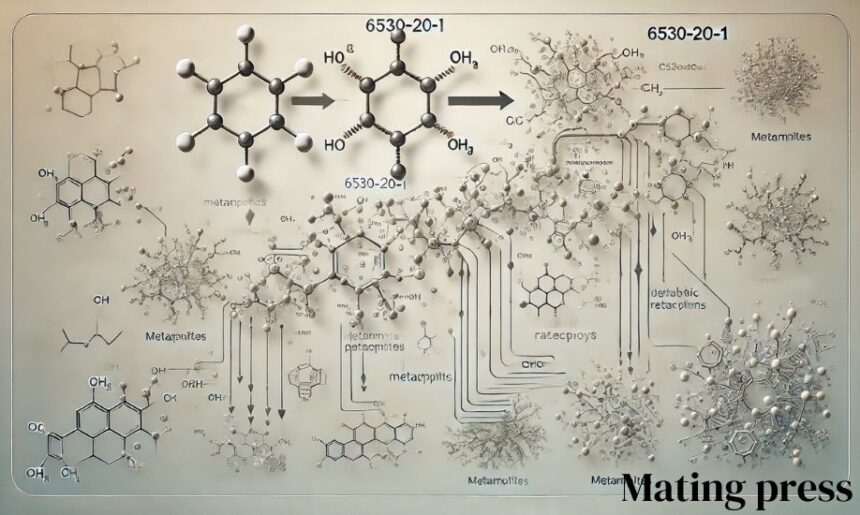Welcome to Mating Press, your trusted source for in-depth scientific articles. In this comprehensive overview, we delve into the intriguing world of 6530-20-1 metabolites. Whether you’re a researcher, student, or simply curious about this specific metabolite, this article aims to provide a thorough understanding of its significance, formation, and potential applications.
What is 6530-20-1 Metabolites?
6530-20-1 metabolites refer to the biochemical products resulting from the metabolism of the compound identified by the CAS number 6530-20-1. Metabolites are essential in various biological processes, acting as intermediates and products of metabolism that facilitate numerous physiological functions. Understanding the metabolites of 6530-20-1 is crucial for comprehending its role in biological systems, potential therapeutic applications, and implications in health and disease.
Chemical Structure and Properties of 6530-20-1
To grasp the nature of 6530-20-1 metabolites, it’s important to first understand the parent compound, 6530-20-1. This substance is characterized by its unique chemical structure, which determines its metabolic pathways and the types of metabolites it produces. Typically, metabolites can be classified into primary and secondary metabolites, each serving different roles within biological systems. The structural properties of 6530-20-1 influence how it interacts with enzymes and other molecules during metabolism.
Metabolic Pathways Involving 6530-20-1
The metabolism of 6530-20-1 metabolites involves a series of enzymatic reactions that transform the parent compound into various metabolites. These pathways can occur in different tissues and organs, such as the liver, where metabolic activity is high. Understanding these pathways is essential for identifying how 6530-20-1 is processed in the body, its duration of action, and potential accumulation of metabolites that might have therapeutic or toxic effects.
Biological Significance of 6530-20-1 Metabolites
6530-20-1 metabolites play a pivotal role in the biological functions of the parent compound. These metabolites can either enhance, diminish, or alter the biological activity of 6530-20-1. For instance, some metabolites may possess greater potency, while others may act as inactive byproducts. Additionally, certain metabolites could have unique biological activities that contribute to the overall effects of 6530-20-1 in therapeutic settings or physiological processes.
Analytical Techniques for Identifying 6530-20-1 Metabolites
Identifying and characterizing 6530-20-1 metabolites requires sophisticated analytical techniques. Methods such as mass spectrometry, nuclear magnetic resonance (NMR) spectroscopy, and high-performance liquid chromatography (HPLC) are commonly employed to detect and quantify metabolites. These techniques enable researchers to map out the metabolic pathways and understand the kinetics of 6530-20-1 metabolism. Accurate identification of metabolites is crucial for drug development, toxicology studies, and personalized medicine approaches.
Applications and Implications of 6530-20-1 Metabolites
The study of 6530-20-1 metabolites has significant implications in various fields, including pharmacology, toxicology, and biotechnology. In pharmacology, understanding the metabolites can aid in the development of more effective and safer drugs by identifying active metabolites that contribute to therapeutic effects or inactive ones that may reduce efficacy. In toxicology, metabolites can be biomarkers for exposure or indicators of potential adverse effects. Furthermore, in biotechnology, engineered metabolic pathways involving 6530-20-1 metabolites can lead to the synthesis of valuable compounds for industrial applications.
Potential Therapeutic Uses of 6530-20-1 Metabolites
Exploring the therapeutic potential of 6530-20-1 metabolites reveals promising avenues for medical advancements. Some metabolites may exhibit unique pharmacological properties that can be harnessed to treat specific diseases or conditions. For example, certain metabolites might have anti-inflammatory, antimicrobial, or anticancer activities. By isolating and studying these metabolites, researchers can develop targeted therapies that maximize beneficial effects while minimizing side effects.
Safety and Toxicity Considerations of 6530-20-1 Metabolites
While 6530-20-1 metabolites offer potential benefits, it is equally important to assess their safety and toxicity profiles. Metabolites can sometimes produce unintended effects, leading to toxicity or adverse reactions. Comprehensive toxicological studies are essential to evaluate the risk associated with exposure to these metabolites, especially in the context of drug development and environmental impact. Understanding the balance between therapeutic efficacy and safety is crucial for the responsible use of 6530-20-1 metabolites.
Future Directions in 6530-20-1 Metabolite Research
The field of 6530-20-1 metabolites is ripe with opportunities for future research. Advancements in analytical technologies and computational modeling are enhancing our ability to study complex metabolic networks and predict metabolite behavior. Future studies may focus on elucidating unknown metabolic pathways, discovering novel metabolites, and exploring the interactions between 6530-20-1 metabolites and other biological molecules. Additionally, personalized medicine approaches could leverage metabolite profiles to tailor treatments based on individual metabolic responses.
Conclusion
In summary, 6530-20-1 metabolites represent a vital aspect of the compound’s overall biological and therapeutic profile. Understanding these metabolites is essential for unlocking the full potential of 6530-20-1 in various applications, from drug development to industrial processes. At Mating Press, we strive to provide detailed and accurate information on such specialized topics, ensuring that our readers are well-informed about the latest advancements and insights in the field of metabolomics.
By exploring the chemical structure, metabolic pathways, biological significance, and potential applications of 6530-20-1 metabolites, this article aims to serve as a valuable resource for anyone interested in the intricate world of metabolism and its implications for science and medicine. As research continues to evolve, the knowledge surrounding 6530-20-1 metabolites will undoubtedly expand, offering new opportunities for innovation and discovery.





